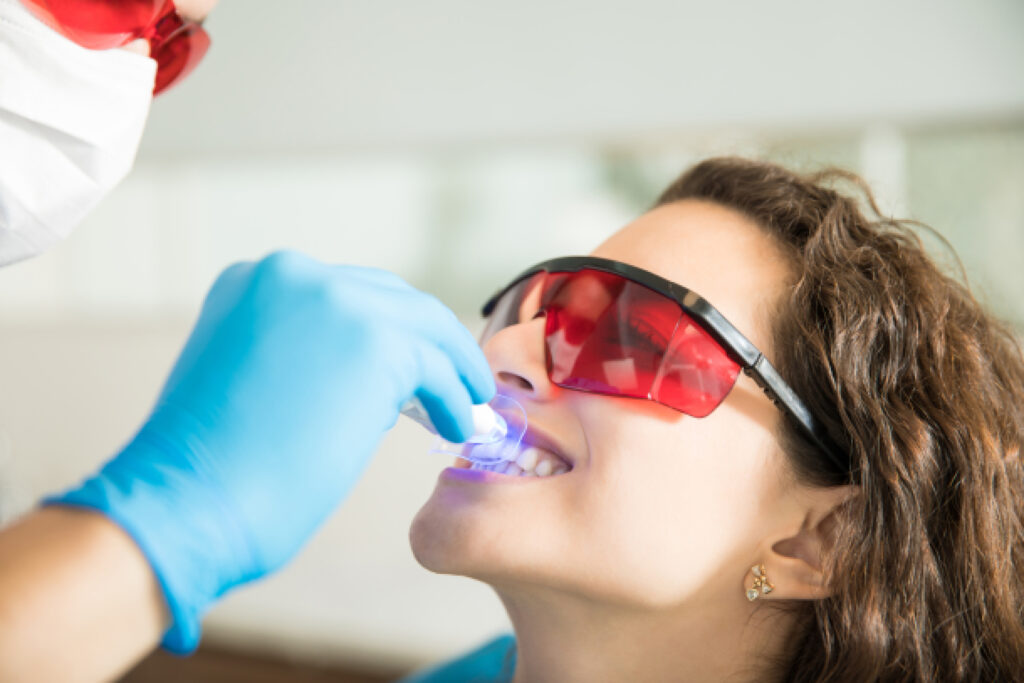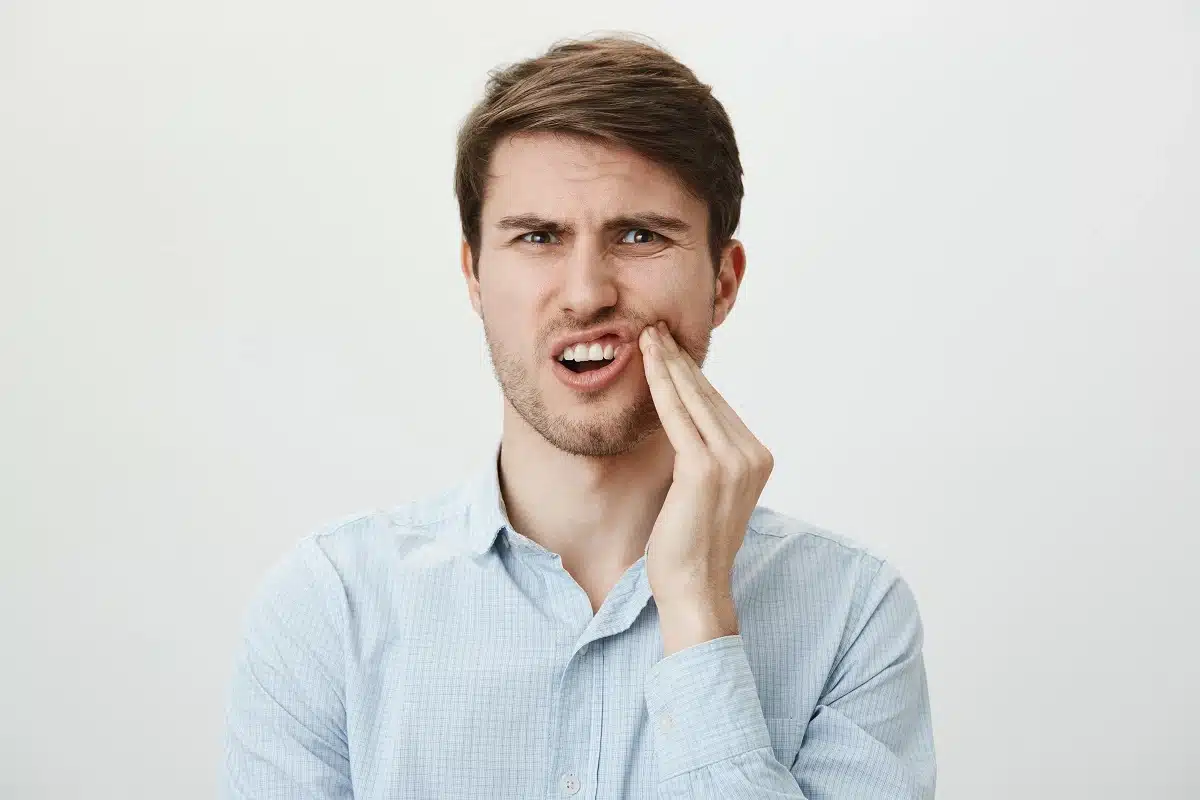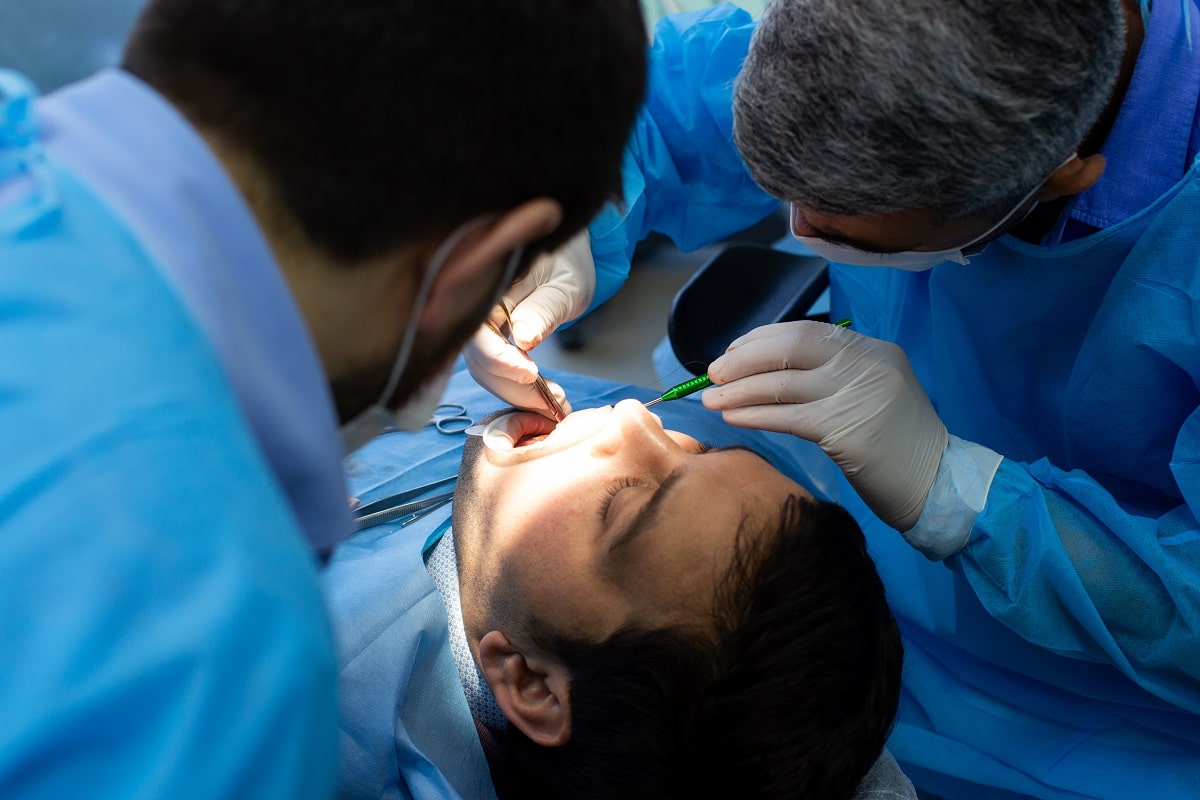Is Teeth Whitening Right for Me?
Before you get a brighter smile, consider a few things to see if teeth whitening is good for you.
1. Dental health
See your dentist: This is super important. Your dentist will check your mouth, find any issues, and decide if whitening is safe and works well for you.
Healthy teeth and gums: Whitening is usually okay for healthy teeth and gums. If you have cavities, gum problems, or sensitive teeth, whitening might worsen things.
Previous dental work: crowns, fillings, and veneers will whiten less than natural teeth. Talk to your dentist about what to expect.
2. Staining type and severity
Outside vs. inside stains: Whitening is better for outside colours, like coffee or smoking. Stains from medications or genes might not get much better.
Shades of white: Tell your dentist how white you want your teeth. Some products make a big difference, but getting super white teeth like in movies might not work for everyone.
3. Personal concerns
Feeling sensitive: Some people think of tooth or gum pain during whitening. Your dentist can suggest things to help or offer different options.
Pregnancy and breast-feeding: It’s safer not to whiten your teeth when pregnant or breast-feeding. Some products might not be safe for the baby.
Other health issues: Tell your dentist about your health problems. Some might need extra care when whitening.
4. Cost and commitment
Professional or at home: Think about how much you want to spend and how much time you can commit. Pros do it faster and watch over you, but it costs more. Home kits are cheaper but take longer and need you to manage them.
Discussing these things with your dentist can determine if whitening is right for you. They’ll help you choose the best way, discuss any worries, and ensure whitening is safe and works well for you.
What Causes Tooth Discoloration?
Many factors contribute to the discolouration of teeth, which can range from subtle yellowing to significant staining. Here are some common causes of tooth discolouration:
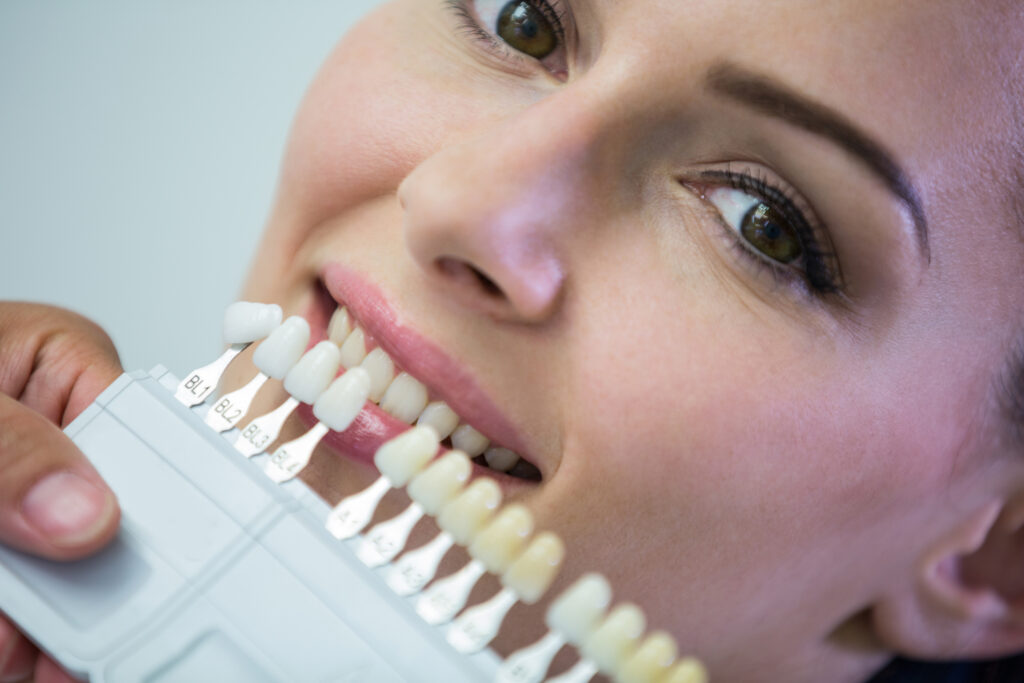
1. Food and Beverages
- Coffee, tea, red wine, & dark sodas: These potent pigments readily stain tooth enamel, leading to gradual yellowing.
- Highly acidic foods: Citrus fruits, vinegar, and acidic sauces can erode tooth enamel, making teeth more susceptible to staining.
- Chromogenic foods: Beets, blueberries, and curry contain intense pigments that can stain both enamel and dentin (the inner layer of teeth).
2. Dental Habits
- Poor oral hygiene: Plaque buildup and inadequate brushing and flossing can cause the formation of tartar, which harbours stain-causing bacteria.
- Smoking: Tobacco use stains teeth a yellow-brown colour and can also lead to gum disease, further exacerbating discolouration.
- Excessive fluoride exposure: Both excessive fluoridated water and fluoride supplements can cause fluorosis, which manifests as white or brown spots on teeth.
3. Medical Conditions and Treatments
- Certain antibiotics, like tetracycline and doxycycline, may cause discolouration in developing teeth, leading to grey or brown staining.
- Chemotherapy and radiation therapy can damage tooth enamel and dentin, making teeth more susceptible to staining.
- Medical conditions: Certain conditions, such as liver disease and iron deficiency anemia, can also contribute to tooth discolouration.
4. Age and Trauma
- Natural aging: Over time, teeth naturally darken due to the thinning of enamel and the accumulation of dentin, which is inherently darker.
- Dental trauma: Injuries to teeth, such as chips or cracks, can expose the darker dentin layer, leading to discolouration.
5. Dental Materials
- Amalgam fillings: These older silver fillings can darken over time, causing a greying appearance of the adjacent tooth.
- Crowns and bridges: Metal-based crowns and bridges can also contribute to discolouration, especially at the margins where they meet the tooth.
Current trends in Teeth whitening?
The teeth-whitening landscape is currently experiencing several significant trends. One major shift is the increasing popularity of home whitening solutions. Convenient and affordable take-home kits and custom-made trays for precise results drive this trend. Subscription models for whitening products are also gaining traction, offering regular refills and support.
Furthermore, safety and natural ingredients are becoming increasingly important. Consumers are opting for natural alternatives like charcoal powder and coconut oil over peroxide-based products due to concerns about potential risks. Vegan and cruelty-free options are also on the rise.
Technology is also crucial in shaping the future of teeth whitening. LED light-based devices are being developed for faster and more effective results, while mobile apps guide users through the whitening process and track progress. AI technology is even being integrated to personalise treatments.
Professional teeth whitening remains popular for those seeking supervised and controlled results. Laser whitening is gaining traction for its dramatic and long-lasting effects, while many opt for combined in-office and at-home approaches.
Social media is also influencing the teeth whitening market. Celebrities and influencers promote products and procedures, while “before and after” photos and testimonials on social media platforms raise awareness of the aesthetic benefits.
Looking ahead, we can expect a continued focus on oral health alongside teeth whitening, encouraging healthy habits for long-term results. Sustainable and eco-friendly products are likely to gain further popularity. Finally, the importance of consulting a dentist before starting any whitening treatment will continue to be emphasised.
How Long Will the Results Last?
The longevity of your brighter smile depends on various factors like individual habits, dietary choices, and the whitening method used. Here’s a breakdown of what you can expect:
Longevity of Whitening Results:
- Professional whitening: Professional in-office treatments typically deliver the longest-lasting results, with effects ranging from 1 to 3 years.
- Take-home whitening kits: These kits generally provide results lasting 4 to 6 months, with touch-ups needed to maintain the desired shade.
- Natural whitening methods: Options like baking soda or charcoal powder may offer subtle results that fade quickly and require more frequent use for noticeable improvement.
Factors Affecting Longevity
- Diet: Continued consumption of stain-causing foods and beverages can significantly shorten the lifespan of your whitening results.
- Oral hygiene: Ensuring good oral hygiene by brushing and flossing daily helps prevent plaque buildup and staining.
- Smoking: Tobacco use can quickly discolour teeth, negating the effects of whitening treatment.
- Underlying causes: Unaddressed underlying causes like medical conditions or dental materials can contribute to re-discoloration.
Touch-Up Treatments
Touch-up treatments may be necessary to maintain your bright smile. The frequency of these treatments depends on the initial whitening method and individual habits. In-office touch-ups can be performed every six months to a year, while take-home kits can be used more frequently as needed.
Tips for Long-Lasting Results:
- Minimise consumption of stain-causing foods and beverages.
- Ensuring oral hygiene by brushing and flossing regularly.
- Consider using a fluoride toothpaste designed for whitening.
- Avoid smoking and tobacco use.
- Schedule regular dental checkups and cleanings.
- Consult your dentist about personalised touch-up options.
Are There Any Side Effects?
While teeth whitening offers numerous benefits, being aware of potential side effects is essential. Here’s a breakdown of the most common side effects and how you can manage them:
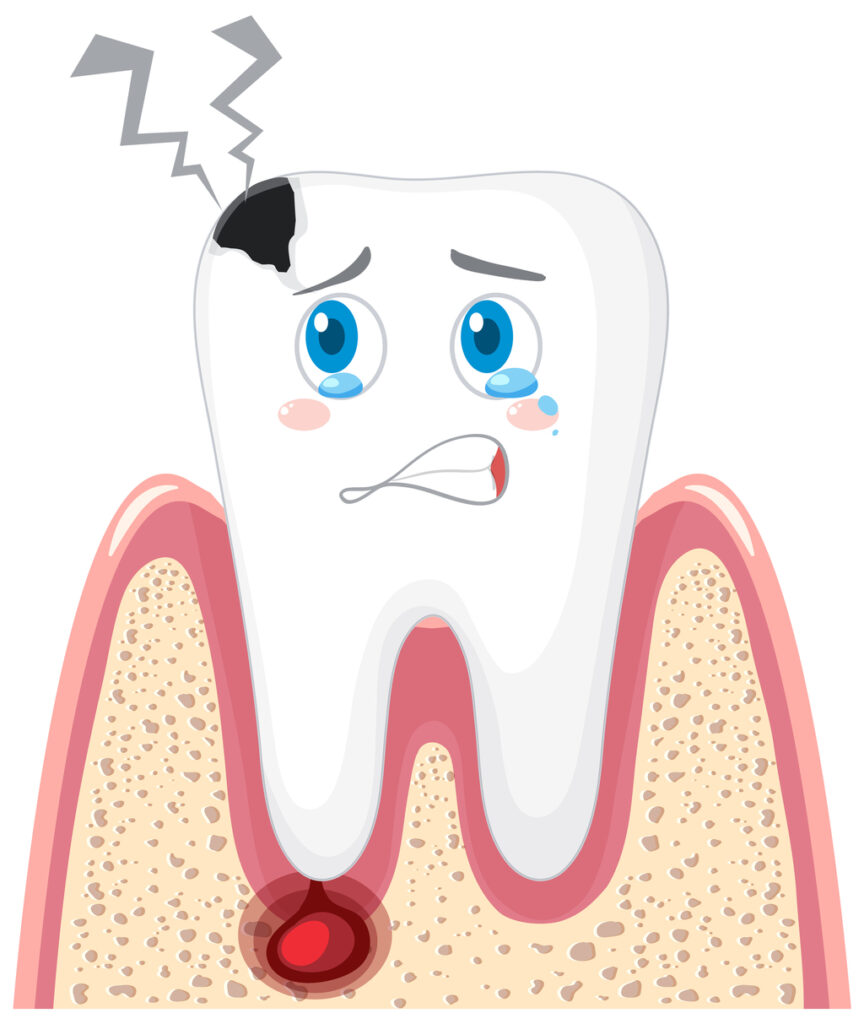
Tooth sensitivity
This is the most common side effect, often experienced as a temporary zinging sensation in the teeth, particularly during and shortly after treatment.
Gum irritation
Bleaching agents used in whitening can irritate the gums, causing redness and soreness
Other potential side effects: Less common side effects include enamel erosion, dry mouth, and altered taste perception
Managing Side Effects:
- Talk to your dentist: Discuss your risk factors and potential side effects before starting whitening treatment.
- Start with a lower concentration of whitening agent: This can help minimise the risk of irritation.
- Take breaks from whitening: If you experience any significant discomfort, discontinue use and consult your dentist.
- Follow the instructions carefully: Overusing whitening products can increase the risk of side effects.
Will Teeth Whitening Affect Existing Dental Work?
While teeth whitening can dramatically improve the appearance of your natural teeth, it’s essential to consider its impact on existing dental work, like crowns, veneers, and bridges. Here’s a breakdown of what you need to know:
Whitening and Existing Dental Work
- The materials used in these restorations do not react to bleaching agents. As a result, they won’t lighten alongside your natural teeth, leading to a noticeable colour difference.
- Fillings: The whitening can affect composite fillings, potentially causing slight discolouration. However, the extent of discolouration varies depending on the filling material used.
- Bonding: Bonding materials can also be affected by the whitening, potentially leading to a slight change in colour.
Considerations Before Whitening
- Material of your dental work: Discuss the material used in your crowns, veneers, fillings, and bonds with your dentist. It helps determine their compatibility with whitening.
- Desired level of whitening: If you have significant existing dental work, achieving a uniform white shade across your entire smile may not be possible.
- Alternative solutions: Discuss alternative options like replacing existing crowns, veneers, or fillings with materials that can be whitened.
Maintaining Harmony
- Whitening sequence: In some cases, it may be recommended to whiten your teeth before getting new crowns or veneers installed to ensure the restorations match the final shade.
- Touch-up considerations: If you have existing dental work, you may need more frequent touch-up treatments for your natural teeth to maintain a harmonious appearance.
What is the Cost of Teeth Whitening?
The cost of teeth whitening in Australia can differ depending on various factors, including the chosen method, location, dental clinic, and individual case complexity. Here’s a breakdown of the financial aspects:
Professional Teeth Whitening
- In-chair whitening: This is the quickest option, offering immediate results. The cost varies from $500 to $1500 per session, with some clinics offering packages for multiple sessions.
- Take-home whitening: This involves custom-fitted trays and whitening gel used at home. The cost typically falls between $250 and $450 per arch.
- Combined approach: Some dentists recommend combining in-chair and take-home methods for optimal results. It can cost upwards of $1500.
Additional Expenses
- Consultation: Most dentists charge a consultation fee to assess your suitability for whitening and discuss options. It can range from $50 to $150.
- Dental X-rays and cleaning: These may be required before whitening, costing around $100 to $300.
- Sensitivity treatment: Some people experience sensitivity during or after whitening. Desensitising products or treatments may add another $50 to $100.
- Maintenance touch-ups: Bleaching effects gradually fade over time. Touch-up treatments or additional gel purchases might be necessary, costing around $100 to $200 per session.
How Many Shades Whiter Can I Expect My Teeth to Become?
Teeth whitening is a famous cosmetic dental procedure that dramatically improves your smile. However, it is essential to have realistic expectations about the level of whitening you can achieve. The number of shades your teeth can lighten depends mainly on your current tooth shade and the chosen whitening method.

Understanding Tooth Shades
The most common tooth shade guide dentists use is the Vita Classical Shade Guide. This guide categories tooth colour into four primary shade ranges:
A: Reddish brown (darkest)
B: Reddish yellow
C: Gray
D: Reddish grey (lightest)
Each shade range is divided into sub-shades, such as A1, A2, B1, etc. It allows for a more precise identification of your current tooth shade.
Factors Affecting Whitening Potential:
- Current tooth shade: Generally, teeth with a lighter starting shade have less potential for dramatic whitening. For example, if your teeth are already a light shade like A1, you might only see a slight improvement to A0. However, if your current shade is darker, like D3, you could achieve a C2 or even B2 shade after whitening.
- Type of whitening: In-chair whitening offers the most dramatic results, potentially lightening teeth by 8-10 shades. Take-home whitening kits typically lighten teeth by 3-5 shades. Over-the-counter whitening products provide the least noticeable results, usually brightening teeth by 1-2 shades.
- Individual factors: The presence of intrinsic stains, genetics, and the overall health of your teeth can impact whitening results.
What is the Procedure Like?
Achieving a brighter smile through teeth whitening involves a specific procedure tailored to your chosen method and desired results.
In-Chair Whitening:
Duration: 1-2 hours, depending on the desired level of whitening.
Number of sessions: Usually requires only one session.
Procedure:
- A protective rubber dam surrounds your gums to shield them from the bleaching agent.
- A high concentration bleaching gel containing hydrogen peroxide is applied to your teeth
- A special light or laser might activate the gel and accelerate the whitening process. This light or laser helps break down the stain molecules and enhance the bleaching effect.
- After achieving the desired whitening level, the gel is thoroughly removed, and your teeth are cleaned.
Take-Home Whitening:
- Duration: 2-4 weeks, depending on the desired results and the concentration of the whitening gel.
- Number of sessions: You’ll need to wear custom-fitted trays filled with bleaching gel for 30-60 minutes daily during treatment.
- Dentists will take impressions of teeth to create transparent, custom-fitted trays that ensure the bleaching gel reaches all tooth surfaces
- You’ll receive detailed instructions from your dentist on adequately using the whitening gel and wearing the trays comfortably and effectively
- Regular follow-up may be necessary to monitor progress and adjust treatment if needed
Pre-Treatment Care:
- Dental cleaning: A thorough professional cleaning is crucial to remove plaque and tartar that can hinder the whitening process and ensure an even whitening result.
- Addressing dental issues: Any cavities, gum disease, or chipped teeth should be addressed before teeth whitening.
Post-Treatment Care:
- Maintaining results: Avoid consuming foods and beverages that may stain teeth, such as coffee, tea, red wine, and berries. It would help if you also avoided smoking as it can stain and yellow your teeth.
- Touch-up treatments: Occasional touch-up sessions with your dentist or home whitening kits might be necessary to maintain your desired whiteness over time.
- Regular dental checkups: Pay attention to your usual dental hygiene routine, including brushing, flossing, and professional cleanings, to maintain good oral health and protect your bright smile.
Is Teeth Whitening Safe?
The safety of teeth whitening is based on the chosen method and individual factors. Consult the dentist to ensure you choose a safe and effective approach. Here are important considerations:
Safety of the Whitening Method:
- Ask your dentist: Discuss the chosen whitening method and its associated risks and benefits. Ensure relevant dental associations approve the plan.
- Ingredients: Understand the active ingredients used in the whitening product and their potential side effects. Opt for products with minimal abrasives and peroxide concentrations to minimise sensitivity and irritation.
- Professional supervision: Consider professional in-chair whitening for more control and management. It allows the dentist to monitor your sensitivity and adjust the treatment accordingly.
- Individual factors: Inform your dentist about any allergies, existing dental conditions, or medications you take, as these might affect the safety of whitening.
Minimising Risks
- Follow instructions: Use the whitening product exactly as directed by your dentist or the manufacturer’s instructions. Overusing the product or exceeding the recommended duration can increase the risk of side effects.
- Manage sensitivity: Some people experience temporary tooth sensitivity during or after whitening. Desensitising toothpaste or gels can help manage this discomfort.
- Maintain good oral hygiene: Regular brushing and flossing are crucial to remove plaque and prevent gum inflammation, which whitening can exacerbate.
- See your dentist regularly: Schedule regular dental checkups to track the health of teeth and gums and address any potential issues arising from whitening.
Can I Whiten My Teeth if I Have Dental Sensitivity?
Having sensitive teeth shouldn’t prevent you from achieving a brighter smile. While some whitening methods can cause discomfort, there are options and precautions to minimise it:
Consult your dentist:
Discuss your sensitivity concerns and whitening goals. They can assess your situation and suggest appropriate methods, like those with milder bleaching agents or shorter treatment durations.
Desensitising solutions:
Consider using desensitising toothpaste or gels before and during whitening. These can help reduce sensitivity by strengthening tooth enamel and blocking pain signals.
Gradual approach:
Begin with a milder whitening product or take-home kit with lower concentrations of bleaching agents. It allows your teeth to adjust gradually and minimises discomfort.
What are the Alternatives to Teeth Whitening?
While teeth whitening is a popular choice, several alternatives can help improve your smile without bleach or chemicals:
Dental Cleaning
Regular professional cleanings remove surface stains and plaque, giving your teeth a brighter, cleaner look.
Veneers or Crowns
These custom-made dental restorations cover discoloured or damaged teeth, offering a more dramatic and permanent solution than whitening.
Bonding
This procedure uses composite resin to repair chips, gaps, and minor stains, restoring the natural shape and colour of your teeth.
Gum Contouring
Gum contouring can reshape the gum line for a more aesthetically pleasing appearance if a gummy smile exposes too much gum tissue.
Can I Continue My Normal Oral Care Routine During and After Whitening?
Maintaining your regular oral hygiene routine is crucial during and after teeth whitening. However, some adjustments might be necessary to optimise results and minimise potential side effects.
Before Whitening
- Professional cleaning: Schedule a professional cleaning before whitening to remove plaque and surface stains, ensuring the whitening agent reaches all tooth surfaces effectively.
- Desensitising toothpaste: If you have sensitive teeth, consider using a desensitising toothpaste before and during whitening to help manage discomfort.
During Whitening
- Continue regular brushing and flossing: Maintain consistent brushing and flossing habits to remove food debris and prevent plaque buildup, which can impede whitening results.
- Avoid abrasive toothpaste: Opt for gentle toothpaste during whitening to minimise enamel erosion and irritation.
- Use a sensitive toothpaste: If you experience sensitivity, switch to a desensitising toothpaste to provide relief.
- Follow your dentist’s instructions: Adhere to your dentist’s specific instructions regarding brushing, flossing, and using mouthwash while whitening.
After Whitening
- Continue good oral hygiene: Maintain your regular brushing and flossing routine to prevent future staining and promote long-lasting results.
- Limit stain-causing foods and beverages: Reduce the utilisation of coffee, tea, red wine, & other staining substances to maintain your whiter smile.
- Touch-up treatments: Consider occasional touch-up treatments or at-home whitening kits to maintain your desired level of whiteness.
- See your dentist regularly: Schedule regular dental checkups to track your oral health and ask about any concerns related to whitening.

